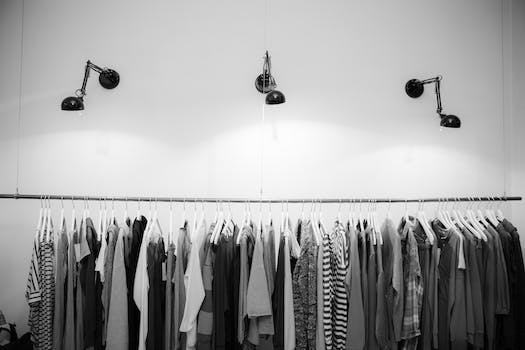How To Start A Business Clothing
“From concept to creation: A guide to launching your own clothing business.”
Introduction
Starting a clothing business can be an exciting and rewarding venture. However, it requires careful planning and execution to ensure success. In this guide, we will provide you with some essential steps to help you start your own clothing business.
Finding Your Niche in the Clothing Industry
Starting a business in the clothing industry can be a daunting task, but with the right approach, it can also be a rewarding and profitable venture. One of the most important steps in starting a clothing business is finding your niche. This means identifying a specific area of the clothing market that you want to focus on and tailoring your products and marketing efforts to meet the needs of that niche.
The first step in finding your niche is to do some research. Look at the current trends in the clothing industry and identify areas that are underserved or have room for growth. For example, you might notice that there is a lack of high-quality, sustainable clothing options for women in their 30s and 40s. This could be a potential niche for your business.
Once you have identified a potential niche, it’s important to do some market research to determine if there is a demand for your products. This can involve conducting surveys, focus groups, or simply talking to potential customers to get their feedback on your ideas. You should also research your competition to see what they are offering and how you can differentiate yourself from them.
Once you have a clear understanding of your niche and the demand for your products, it’s time to start developing your brand. This involves creating a unique identity for your business that will resonate with your target audience. Your brand should reflect the values and personality of your business, and should be consistent across all of your marketing materials, including your website, social media profiles, and product packaging.
When it comes to product development, it’s important to focus on quality and functionality. Your products should be well-made and designed to meet the specific needs of your niche. For example, if you are targeting women in their 30s and 40s who are looking for sustainable clothing options, your products should be made from high-quality, eco-friendly materials and designed to be versatile and long-lasting.
Marketing is also a key component of finding your niche in the clothing industry. You should develop a marketing strategy that is tailored to your target audience and focuses on the unique benefits of your products. This might involve creating social media campaigns, partnering with influencers, or hosting events to showcase your products.
Finally, it’s important to stay flexible and adaptable as you grow your business. Your niche may evolve over time as you learn more about your customers and the market, and you may need to adjust your products and marketing strategies accordingly. By staying open to feedback and willing to make changes, you can ensure that your business stays relevant and successful in the ever-changing world of fashion.
In conclusion, finding your niche in the clothing industry is a crucial step in starting a successful business. By doing your research, developing a strong brand, focusing on quality and functionality, and creating a targeted marketing strategy, you can position your business for long-term success. Remember to stay flexible and adaptable as you grow your business, and always keep your customers’ needs and preferences at the forefront of your decision-making process. With the right approach, you can turn your passion for fashion into a thriving business.
Creating a Business Plan for Your Clothing Company

Starting a clothing business can be an exciting and rewarding venture. However, it requires careful planning and execution to ensure success. One of the most important steps in starting a clothing business is creating a business plan. A business plan is a roadmap that outlines your goals, strategies, and financial projections for your company. In this article, we will discuss the key elements of a business plan for a clothing company.
Executive Summary
The executive summary is the first section of your business plan and should provide a brief overview of your company and its goals. It should include a mission statement, a description of your products or services, and a summary of your financial projections.
Market Analysis
The market analysis section should provide an in-depth analysis of your target market. This includes information on the size of the market, the demographics of your target customers, and the competition in the industry. You should also include information on the trends and opportunities in the market that your company can capitalize on.
Products and Services
In this section, you should provide a detailed description of your products or services. This includes information on the materials used, the design process, and any unique features or benefits of your products. You should also include information on your pricing strategy and how you plan to position your products in the market.
Marketing and Sales Strategies
The marketing and sales strategies section should outline how you plan to promote and sell your products. This includes information on your advertising and promotional activities, as well as your sales channels. You should also include information on your pricing strategy and how you plan to position your products in the market.
Operations and Management
The operations and management section should provide information on how your company will be structured and managed. This includes information on your organizational structure, staffing requirements, and any legal or regulatory requirements that you need to comply with. You should also include information on your production process and any suppliers or vendors that you will be working with.
Financial Projections
The financial projections section should provide a detailed analysis of your company’s financial performance. This includes information on your revenue projections, expenses, and cash flow. You should also include information on your funding requirements and any sources of funding that you plan to use.
Conclusion
Creating a business plan is an essential step in starting a clothing business. It provides a roadmap for your company and helps you to identify the key factors that will contribute to your success. By following the key elements outlined in this article, you can create a comprehensive and effective business plan for your clothing company. With careful planning and execution, you can turn your passion for fashion into a successful and profitable business.
Building Your Brand Identity and Marketing Strategy
Starting a clothing business can be an exciting and rewarding venture. However, it can also be a daunting task, especially if you are new to the industry. One of the most important aspects of starting a clothing business is building your brand identity and marketing strategy. In this article, we will discuss some tips on how to do just that.
First and foremost, it is important to define your brand identity. Your brand identity is what sets you apart from your competitors and makes your clothing line unique. To define your brand identity, you need to consider your target audience, your values, and your mission statement. Who are you designing for? What do you stand for? What is your purpose? Answering these questions will help you create a brand identity that resonates with your target audience.
Once you have defined your brand identity, it is time to create a marketing strategy. Your marketing strategy should be tailored to your target audience and should include a mix of online and offline marketing tactics. Some effective online marketing tactics include social media marketing, email marketing, and influencer marketing. Offline marketing tactics include attending trade shows, hosting pop-up shops, and collaborating with other businesses.
Social media marketing is one of the most effective ways to reach your target audience. Platforms like Instagram, Facebook, and Twitter allow you to showcase your clothing line and connect with potential customers. To make the most of social media marketing, it is important to post regularly, engage with your followers, and use hashtags to increase your reach.
Email marketing is another effective way to reach your target audience. By collecting email addresses from your website visitors and customers, you can send them newsletters, promotions, and updates about your clothing line. To make the most of email marketing, it is important to segment your email list and personalize your emails.
Influencer marketing is a great way to reach a wider audience and build credibility for your brand. By partnering with influencers in your niche, you can showcase your clothing line to their followers and gain exposure. When choosing influencers to work with, it is important to consider their audience demographics, engagement rates, and authenticity.
Offline marketing tactics are also important for building your brand identity and reaching your target audience. Attending trade shows and hosting pop-up shops allow you to showcase your clothing line in person and connect with potential customers. Collaborating with other businesses can also help you reach a wider audience and build credibility for your brand.
In conclusion, building your brand identity and marketing strategy is crucial for the success of your clothing business. By defining your brand identity and creating a marketing strategy that resonates with your target audience, you can reach a wider audience and build credibility for your brand. Remember to use a mix of online and offline marketing tactics, and to always stay true to your brand identity and values. With hard work and dedication, you can build a successful clothing business that stands out in the industry.
Sourcing Materials and Manufacturing Your Clothing Line
Starting a clothing business can be an exciting and rewarding venture. However, it can also be a daunting task, especially if you are new to the industry. One of the most important aspects of starting a clothing business is sourcing materials and manufacturing your clothing line. In this article, we will discuss some tips on how to source materials and manufacture your clothing line.
Sourcing Materials
The first step in starting a clothing business is to source materials. This can be a challenging task, especially if you are not familiar with the textile industry. Here are some tips on how to source materials for your clothing line:
1. Research: The first step in sourcing materials is to do your research. You need to know what type of fabric you want to use, where to find it, and how much it will cost. You can start by researching online or visiting textile trade shows.
2. Build relationships: Building relationships with suppliers is crucial in the textile industry. Attend trade shows, visit fabric stores, and network with other designers to find reliable suppliers.
3. Quality: Quality is key when it comes to sourcing materials. Make sure you choose high-quality fabrics that will last and look good.
4. Sustainability: Consider using sustainable materials for your clothing line. Consumers are becoming more conscious of the impact of their purchases on the environment, and using sustainable materials can be a selling point for your brand.
Manufacturing Your Clothing Line
Once you have sourced your materials, the next step is to manufacture your clothing line. Here are some tips on how to manufacture your clothing line:
1. Find a manufacturer: Finding a manufacturer can be a challenging task, especially if you are new to the industry. You can start by researching online or attending trade shows. You can also consider working with a sourcing agent who can help you find a manufacturer.
2. Communication: Communication is key when working with a manufacturer. Make sure you have clear communication with your manufacturer to ensure that your vision is being executed correctly.
3. Quality control: Quality control is crucial when manufacturing your clothing line. Make sure you have a system in place to ensure that your products meet your standards.
4. Cost: Cost is an important factor to consider when manufacturing your clothing line. Make sure you have a budget in place and negotiate with your manufacturer to get the best price possible.
5. Timelines: Timelines are important when manufacturing your clothing line. Make sure you have a production schedule in place and communicate your timelines with your manufacturer.
In conclusion, sourcing materials and manufacturing your clothing line can be a challenging task, but with the right research and planning, it can be a rewarding experience. Remember to focus on quality, sustainability, and communication when sourcing materials and manufacturing your clothing line. Good luck on your journey to starting a successful clothing business!
Launching Your Clothing Business and Scaling for Growth
Starting a clothing business can be an exciting and rewarding venture. However, it can also be a daunting task, especially if you are new to the industry. In this article, we will guide you through the process of launching your clothing business and scaling it for growth.
1. Develop a Business Plan
The first step in starting any business is to develop a solid business plan. Your business plan should include your mission statement, target market, marketing strategy, financial projections, and operational plan. This plan will serve as a roadmap for your business and help you stay on track as you grow.
2. Choose Your Niche
The clothing industry is vast, and there are many niches to choose from. You need to identify your niche and determine what sets your brand apart from the competition. This could be your unique design style, your commitment to sustainability, or your focus on a specific demographic.
3. Create a Brand Identity
Your brand identity is what sets you apart from the competition and helps you connect with your target audience. This includes your brand name, logo, website, and social media presence. Make sure your brand identity is consistent across all platforms and reflects your brand values.
4. Source Your Materials
Once you have your business plan and brand identity in place, it’s time to source your materials. This includes fabrics, trims, and other materials needed to create your clothing line. You can source materials locally or internationally, depending on your budget and production needs.
5. Create Your Designs
With your materials in hand, it’s time to start creating your designs. This is where your creativity comes into play. You can create your designs using software or by sketching them out by hand. Make sure your designs are unique and reflect your brand identity.
6. Produce Your Clothing Line
Once you have your designs finalized, it’s time to produce your clothing line. You can either produce your clothing in-house or outsource production to a manufacturer. Make sure you have a quality control process in place to ensure your clothing meets your standards.
7. Launch Your Brand
With your clothing line produced, it’s time to launch your brand. This includes creating a launch strategy, setting up your website and social media accounts, and reaching out to influencers and media outlets. Make sure you have a strong marketing strategy in place to generate buzz around your brand.
8. Scale for Growth
As your brand grows, you will need to scale your business to meet demand. This includes expanding your product line, increasing production, and hiring additional staff. Make sure you have a solid financial plan in place to support your growth.
In conclusion, starting a clothing business requires careful planning and execution. By following these steps, you can launch your brand and scale it for growth. Remember to stay true to your brand values and always put your customers first. With hard work and dedication, you can build a successful clothing business.
Conclusion
To start a business in the clothing industry, you need to conduct market research, create a business plan, secure funding, choose a business structure, register your business, and establish a brand identity. It is also important to source quality materials, design unique products, and market your brand effectively. With dedication, hard work, and a solid strategy, you can successfully launch and grow a clothing business.






